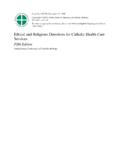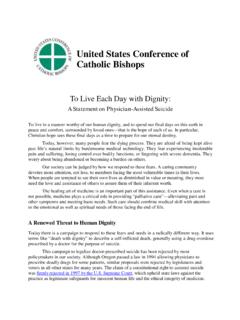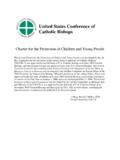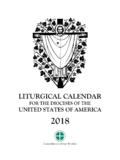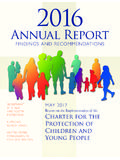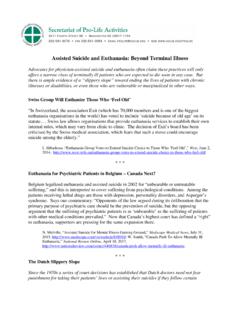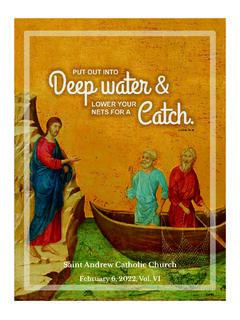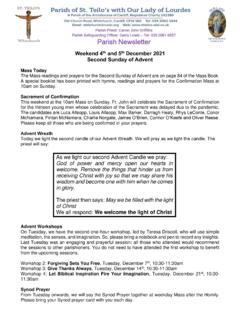Transcription of Lex Orandi, Lex Credendi: The Word of God in the ...
1 lex orandi , Lex credendi : The Word of God in the Celebration of the Sacraments1In the beginning was the Word, and the Word was with God, and the Word was was in the beginning with God..And the Word became flesh and made his dwelling among us, and we saw his glory, the glory as of the Father s only Son, full of grace and truth. John 1:1-2, 14 The Prologue of the Gospel according to John articulates concisely the theology of the Incarnation: Jesus is one with the Father from the beginning (true God), and he became flesh and lived as one of us (true man). The Preface of the Eucharistic Prayer for Christmas also articu-lates the mystery of the Incarnation: In the wonder of the incarnation, your eternal Word has brought to the eyes of faith a new and radiant vision of your glory.
2 In him we see our God made visible and so are caught up in the love of the God we cannot see (Sacramentary, P3). When the Church encounters Christ in the celebration of the sacraments, especially in the celebration of the Eucharist, an incarnation takes place; a word becomes flesh. And as a particular word is expressed, an aspect of the faith is articulated in matter and form. This is the nature of the Church s liturgy, in which the faithful encounter Christ in sacramental signs: tangible expressions or incarnations of the presence of Christ. This essay explores the place of the Word in the litur-gical life of the Church, focusing especially on two particular aspects: the proclamation and wit-ness of the faith in the liturgical context, and the use of Scripture in the celebration of the orandi, lex credendi has become something of a tenet of liturgical theology, especially in the years since the reforms of the Second Vatican Council.
3 Literally translated, it means the law of prayer [is] the law of belief. This axiom is an adaptation of words of Prosper of Aquitaine, a fifth-century Christian writer and a contempo-rary of St. Augustine. The original version of the phrase, ut legem credendi lex statuat supplicandi ( that the law of praying establishes the law of believing ), highlighted the understanding that the Church s teaching (lex credendi ) is articulated and made manifest in the celebration of the liturgy and prayer ( lex orandi ).1 We understand this to mean that prayer and worship is the first articulation of the faith. The liturgy engages belief in a way that simply thinking about God or studying the faith does not naturally do. In other words, in an act of worship, the faithful are in dialogue with God and are engaged in an active and personal relationship with Jesus Christ, and every individual member of the liturgical assem-bly is connected to one another as members of the mystical Body of Christ in the Holy Spirit, as they look together with hope for the salvation promised in the Kingdom of Heaven.
4 Theology, christology, ecclesiology, pneumatology, and eschatology are all expressed in word and deed, in sign and symbol, in liturgical earliest preaching of the Word of God by the Apostles, the kerygma, was understood to be manifest in a particular way in the liturgy, in the celebration of the Eucharist. St. Paul 1 For a more thorough study of Prosper of Aquitaine s text, see kevin Irwin, Context and Text: Method in Liturgical Theology (Collegeville, MN: Liturgical Press, 1994). expresses this function of the liturgy: For as often as you eat this bread and drink the cup, you proclaim the death of the Lord until he comes (1 Cor 11:26). The Church understands this close relationship between liturgy and the faith even today. In the National Directory for Catechesis (NDC), the United States Conference of Catholic Bishops (USCCB) states that faith and worship are as closely related to one another as they were in the early Church: faith gathers the community for worship, and worship renews the faith of the community ( 32 [Washington, DC: USCCB, 2005]).
5 The restored catechumenate in the Rite of Christian Initiation of Adults (RCIA) anticipates an instruction that, while presenting Catholic teaching in its entirety also enlightens faith, directs the heart toward God, fosters participa-tion in the liturgy, inspires apostolic activity, and nurtures a life completely in accord with the spirit of Christ (no. 78 [Washington, DC: USCCB, 1988]). Thus the goal of the catechu-menate is to promote an understanding that the liturgy and the sacraments catechize not only in the proclamation of the Word and in preach-ing, but in the celebration of the rites them-selves. The RCIA restored an ancient custom for sacramental catechesis that, in many places in the Church today, is somewhat unknown. If the ancient tradition is followed, catechesis on the sacraments not only is provided during the catechumenate but also follows after the celebra-tion of the sacraments as mystagogical cateche-sis, which is the unfolding of the mysteries that have been celebrated.
6 The RCIA explains that, during the period of mystagogical cateche-sis, the neophytes (that is, the newly initiated) are introduced into a fuller and more effec-tive understanding of the mysteries through the Gospel message they have learned and above all through their experience of the sacraments they have received (no. 245). This process highlights the mysteries themselves as a source of proclama-tion and instruction in the Cyril of Jerusalem, a fourth-century bishop of Jerusalem, wrote and delivered an extended catechesis surrounding the Sacraments of Initiation. Some of the lectures were given to candidates for Baptism (catechumens) in the weeks prior to Baptism, while other lectures were delivered after Baptism. Prior to Baptism, his instruction focused on the Creed.
7 The post-baptismal catechesis, St. Cyril s Mystagogical Catechesis, provided instruction on the nature of the sacraments themselves. At the beginning of the first of those lectures, St. Cyril states,I long ago desired, true-born and dearly beloved children of the Church, to discourse to you concerning these spiritual and heav-enly Mysteries; but knowing well, that seeing is far more persuasive than hearing, I waited till this season; that finding you more open to the influence of my words from this your experience, I might take and lead you to the brighter and more fragrant meadow of this present paradise; especially as ye have been made fit to receive the more sacred Mysteries, having been counted worthy of divine and life-giving Baptism.
8 It remaining therefore to dress for you a board of more perfect instruc-tion, let us now teach you exactly about these things, that ye may know the deep meaning to you-ward of what was done on that eve-ning of your baptism. (St. Cyril of Jerusalem, Mystagogical Catechesis, in St. Cyril of Jerusalem: Lectures on the Christian Sacraments, ed. F. L. Cross [Crestwood, NY: St. Vladimir s Seminary Press, 1995], ) What St. Cyril demonstrates is that instruc-tion on the sacraments benefits from the perspec-tive of having celebrated them. The grace given in the sacraments is what enlightens; merely to talk about them is not sufficient. And although he was preaching to adults who were newly baptized, St. Cyril s method can be applied to the Sacraments of Initiation celebrated with young people (chil-dren of catechetical age and adolescents) and the broad range of the faithful in ongoing formation 2and catechesis as well.
9 Pope Benedict XVI, in his 2007 post-synodal apostolic exhortation The Sacrament of Charity (Sacramentum Caritatis), explains well the relationship between the sacra-ments and our understanding of the faith:The Church s faith is essentially a eucha-ristic faith, and it is especially nourished at the table of the Eucharist. Faith and the sacraments are two complementary aspects of ecclesial life. Awakened by the preaching of God s word, faith is nourished and grows in the grace-filled encounter with the Risen Lord which takes place in the sacraments: faith is expressed in the rite, while the rite reinforces and strengthens faith. (no. 6 [Washington, DC: USCCB, 2007])In addition to the rites themselves ( lex orandi ), which communicate what the Church believes (lex credendi ), the liturgy also makes extensive use of the written Word of God in the Scriptures.
10 Every liturgical rite (including the celebration of the Mass and the other sacraments, the Liturgy of the Hours, and other rites of the Rituale Romanum) includes the proclamation of one or more biblical readings, especially read-ings from the Gospels. The liturgical texts them-selves orations, exhortations, and blessings draw from the Scriptures, too: particular images, sayings, and expressions are often quoted directly from biblical texts. The book of Psalms, the first prayer book of the Church, has always been a source of the language of liturgical prayer. The relationship between the liturgy and the written Word of God does not, however, end here. There is evidence that some texts of both the Old and New Testaments were themselves influenced by liturgical worship.
